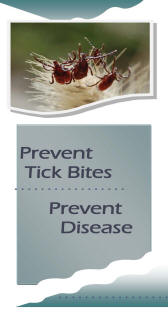Lyme Disease What is Lyme Disease?
What is Lyme Disease?Lyme Disease (LD) is caused by the bacterium
Borrelia burgdorferi,
and is transmitted to humans by the bite of an infected western blacklegged tick
(
Ixodes pacificus) in much of the western United States and by the blacklegged
or deer tick
Ixodes scapularis in other parts of the country. The reservoir for
B. burgdorferi is small rodents, with deer as a secondary reservoir. Ticks that
feed on infected rodents or deer may then transmit the disease to humans. The western
blacklegged tick has been recovered from 56 of 58 California (CA) counties, including
Los Angeles County (CA Department of Health Services, unpublished data). Several surveys
have estimated that only 1.0-1.5% of adult
I. pacificus ticks are infected with
B.
burgdorferi, compared to an infection rate of 20-40% in
I. scapularis
ticks in the Northeast US. Thus LD is not acquired frequently in Los Angeles County (LAC).
LD has been a reportable disease in CA since 1989, and each year from 20 to 30 suspected
cases of LD are reported to LAC Public Health by clinicians and laboratories. However, few
of these reports meet the Centers for Disease Control and Prevention (CDC) case definition
for confirmed LD. The number of confirmed LD cases in LAC has varied from zero to eight cases
a year. But most reported LD cases are acquired outside LAC; in most years only one case is
acquired within LAC. For example, in 2003, six confirmed cases were reported among county
residents, but five of them reported tick exposure outside of LAC.
Signs and SymptomsThe first sign of LD is usually a distinctive circular rash called erythema
migrans or EM, which resembles an expanding red bullís eye rash. EM occurs in 60-90% of
patients and usually occurs within 3-32 days at the site of the tick bite. If there is no
rash, other early symptoms such as fever, body aches, headaches, and fatigue are often
unrecognized as indicators of LD. Later, if untreated, patients may develop other problems
such as aseptic meningitis, cranial neuritis, heart arrhythmias, and arthritis of the large
joints.
DiagnosisThe diagnosis of LD may be difficult because many other diseases cause symptoms such as
fever, headache, fatigue, and body ache. Laboratory tests are often not sensitive,
specific or consistent, and are frequently misinterpreted. If you think you may have LD,
please consult with your medical provider for appropriate diagnostic tests and treatment.
Early LD is treated with a short course of an oral antibiotic such as doxycycline, while
late disease requires longer treatment with either oral or intravenous antibiotics.
PreventionSteps to prevent LD include:
-
use insect repellants containing from 10% to 35 % DEET when camping and hiking
-
wear light-colored long pants and long sleeved clothing so that ticks are easier to
spot before they attach to the skin
-
remove ticks promptly, since attachment of more than 24 hours is required for
disease transmission.
-
avoid overgrown brush by walking in the center of the trail, and remove brush from
personal residences.
-
For more information about LD, visit the following websites:
Los Angeles County
Centers for Disease Control and
Prevention (CDC)
California Department of Public Health

